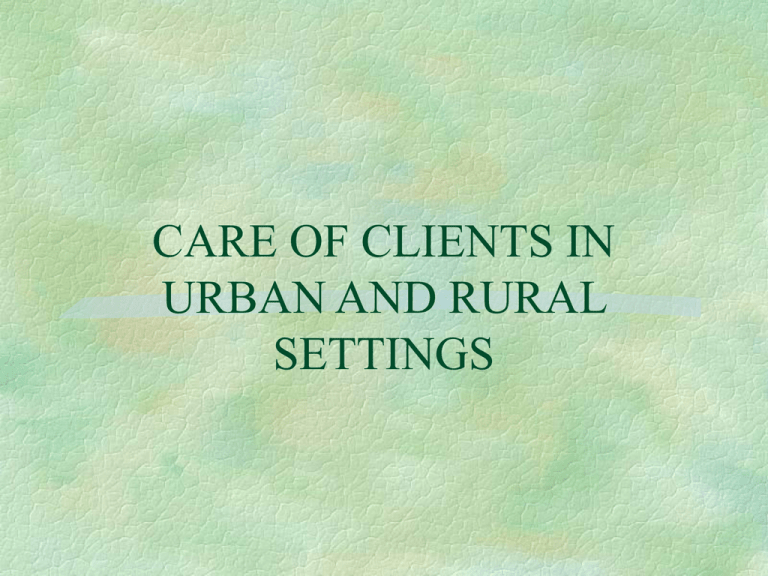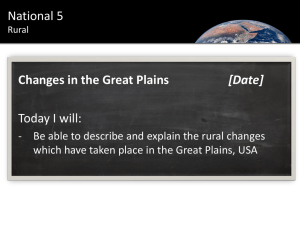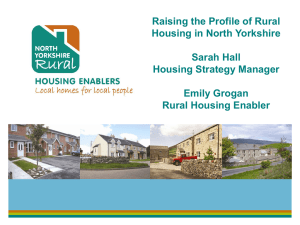CARE OF CLIENTS IN URBAN AND RURAL SETTINGS
advertisement

CARE OF CLIENTS IN URBAN AND RURAL SETTINGS Approaches to Defining Rural and Urban U. S. Census Bureau Office of Management and Budget (OMB) Montana State University Rurality Index U.S. Census Bureau (1990) Based on population density Urban: “one or more places and the adjacent densely settled surrounding territory that together have a minimum population of 50,000 persons” Rural: Any area that does not meet the definition of urban OMB Classification Based on the presence of a city or suburbs and the degree of integration of that territory with city or suburb Operationalized in USDA continuum codes USDA Continuum Codes - 1 Metropolitan Counties 0 - Central counties of metropolitan areas with populations of 1 million or more people 1 - Metropolitan counties on the fringe of central counties that have populations of 1 million or more people 2 - Metropolitan counties with populations of 250,000 to 1 million people 3 - Counties in metropolitan areas with populations less than 250,000 people USDA Continuum Codes - 2 Non-metropolitan Counties 4 - Urban populations of 20,000 or more people adjacent to a metropolitan area 5 - Urban populations of 20,000 or more people, not adjacent to a metropolitan area 6 - Urban populations of 2,500 to 19,999 people adjacent to a metropolitan area USDA Continuum Codes - 3 Non-metropolitan Counties 7 - Urban populations of 2,500 to 19,999 people not adjacent to a metropolitan area 8 - Completely rural areas or areas with urban populations of less than 2,500 people adjacent to a metropolitan area 9 - Completely rural areas or areas with urban populations of less than 2,500 people, not adjacent to a metropolitan area MSU Rurality Index Classifies counties based on Population density Distance to health care services Classifies residents based on Distance to health care services only Frontier An area or county that has a population density of less than 7 people per square mile Characteristics of Rural Nursing “The provision of health care by professional nurses to persons living in sparsely populated areas” (Source: Long & Weinert, 1998). Characteristics of Urban Nursing Care of clients who reside in an urban setting Concepts of Rural Nursing Theory Work beliefs and health beliefs Isolation and distance Self-reliance Lack of anonymity Insider/outsider status Old-timer/newcomer (Source: Long & Weinert, 1998) Rural Nursing Generalist practice Expectations of competence in many areas, expertise in a few Expanded scope of practice Blurring of disciplinary boundaries More intimate knowledge of clients in multiple types of interactions Urban Nursing Greater opportunity for specialization Narrower scope of practice More rigid disciplinary boundaries Less intimate interactions with clients Biophysical Factors Urban Higher overall mortality Higher AIDS mortality Lower child immunization rates Higher elder immunization rates Rural More elderly More children Overall higher morbidity Poorer self-reported health Higher injury mortality Psychological Factors Urban Lower suicide mortality rates Equal levels of stress, but different sources Rural Fewer mental health services available Lower rates of psychiatric beds Physical Environmental Factors Urban Greater influence of built environment Greater exposure to pollutants, noise More energy efficient Lack of housing Rural Greater influence of natural environment Greater exposure to pesticides Great distances Greater potential for plant/animal exposures Rundown housing Sociocultural Factors - 1 Urban Greater heterogeneity Social isolation Greater mobility Exposure to unconventional norms More agency services Rural Greater homogeneity Sustained interactions Traditional gender roles Informal support networks Sociocultural Factors - 2 Urban Diffused responsibility Higher crime rates Less family support More visible homeless Better economic base for health Rural Lack of privacy Greater poverty Fewer single-parent households Lower education Lack of OSHA coverage Behavioral Factors Urban More underweight More smoking More drug and alcohol use Rural More obesity More smokeless tobacco use Less leisure activity More sexual risks Less health promotion behavior Health System Factors Urban More services available Higher reimbursement rates Greater managed care availability Greater convenience Rural Fewer providers Great distances to services Less insurance coverage Inappropriate MCO models Goals for Care in Urban and Rural Settings - 1 Increase access to health care services and decrease barriers to their use Eliminate or modify environmental risk factors Modify social conditions that adversely affect health Goals for Care in Urban and Rural Settings - 2 Increase clients’ abilities to make informed health decisions Develop systems of care that are population appropriate Develop equitable health care policies that address the diverse needs of urban and rural populations Means for Achieving Goals Will differ based on: Population needs Risk factors involved Population characteristics (e.g., culture, age, etc.) Evaluation of Care in Urban and Rural Settings Focuses on: Individual client outcomes Population outcomes Achievement of national objectives







